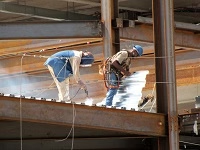HOW TO WEAR A HARD HAT PROPERLY
Resource Center Topics
Coronavirus Information
Ebola Information
Ebola Virus Information
Ebola Donning
Ebola Doffing & Disposal
Hearing Protection
Avian Bird Flu Information
Chemical Safety
General Workplace Safety
Basic First Aid
Ergonomics
OSHA Checklist for General Industry
Welding Safety
Healthcare/Laboratory
Electrical Safety
Hard Hats can be a life saver
Wearing a hard hat can save your life. Tackling construction, road work, and many other physically laborious jobs without head gear can result in serious and even fatal injuries. However, unlike other accessories, like work gloves or safety glasses, simply tossing a helmet on your noggin won't guarantee infallible protection. Learning how to wear a hard hat can be just as important as knowing when you need to put one on.
Find the Right Fit
You cannot safely wear a hard hat without first knowing how one should fit on your unique head shape. The ideal fit for such head gear will leave a little breathing room between the hard shell and the internal suspension structure so that air can flow freely through the area . If you are wearing a hard hat that does not offer such a spacious fit, you aren't necessarily out of luck. Many models are designed to be adjusted to the user's shape. Common features include sliding mechanisms that allow you to adapt the tightness at 1/8 inch intervals. When fine-tuning your fit, try to find a spot in which the hard hat feels secure, yet not painfully tight. Skin abrasions of any kind are a sign that you are not wearing your hard hat at an appropriate size.

Top Selling Hard Hat Products










Remove Any Other Head Wear Unless Specially Designed

Although official OSHA and ANSI guidelines on how to wear a hard hat do not restrict users from donning all kinds of head apparel, they do contain suggestions as to what kind of gear can be worn . During cold weather months, workers may add a thin layer between the helmet and the head. However, not just any beanie or knitted cap will do. OSHA recommends that users wear only specially designed hard hat liners. Such garments are engineered to fit securely without degrading the functionality of the work helmet. Not sure how to know if you can wear a certain product with your hard hat? Different models are compatible with different liners, so it is a good idea to direct any uncertainties toward the product manufacturer to ensure an optimal fit. Again, if it isn't designed specifically to be worn with a hard hat, like baseball caps, headbands, or bandanas, it is best to leave it off for a slip-free wearing experience.
Make Sure the Hard Hat is Oriented Properly
When applying your hard hat, make sure that the bill of the cap is pointing toward the front of the head . It is possible to put your gear on backwards and doing so will reduce the efficacy of the product. Most newer models are crafted to be worn both forwards and backwards and include a reverse donning arrow marking to denote this versatile usage feature.
If your helmet does not include such labels, the best way to wear the hard hat would be with the brim pointing straight ahead. Application techniques may differ from product to product, so review the manufacturer's instructions for placing the hat on your head.
If you follow all of these steps as well as any manufacturer instructions specific to your unique gear, you'll know how to properly wear any hard hat. No matter what safety apparel you don, it should always be applied before entering potentially hazardous situations. With the right equipment, you can help protect yourself and others from unexpected accidents in the workplace.
References:
1-https://www.osha.gov/Publications/osha3151.html
2-https://www.osha.gov/pls/oshaweb/ owadisp.show_document?p_table=INTERPRETATIONS& p_id=25336
3-https://www.osha.gov/Publications/osha3151.html
